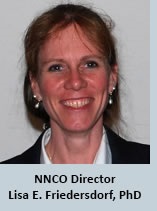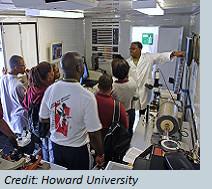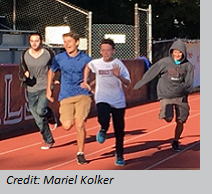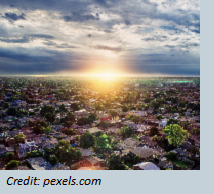|
|
WHAT'S BIG IN SMALL SCIENCE? A Quarterly Newsletter of the National Nanotechnology Coordination Office (NNCO) |
|
DIRECTOR'S CORNER
One of the things I love most about my position is the collaborative environment enabled by the NNI. I not only have the pleasure of working with extraordinary colleagues across the U.S. Government and a great staff at the NNCO, but I also get to spend a lot of time in the nanotechnology community. I especially enjoy engaging with the researchers and developers who are on the front lines, pushing the frontiers of nanoscience, developing the research infrastructure (the physical tools to fabricate and characterize nanomaterials and nanotechnology-enabled devices and systems as well as the cyber tools for modeling and simulation), and taking these discoveries to market. Over the past several months, I have had the opportunity to get out into the community (see highlights below) to present information about the NNI, to learn about the advances in and needs of the community, and most importantly, to bring that information back to share with colleagues and make connections. I am genuinely excited by what I’ve seen, from nanoscale mesh electronics that can be injected into the eye or the brain to study the retina or track the activity of a single neuron over time, to targeted nanotechnology solutions to combat bacterial infections in agriculture. I’m excited by the advancements in water purification, energy harvesting, photonics, advanced computing, and wearable sensors to improve health monitoring. And I’m especially excited when I talk to the people who are taking these research breakthroughs into the market. |
|
HIGHLIGHTS FROM THE NNI On Aug. 27, 2018, NSF awarded $1.8 million to a team of scientists led by John Badding, professor of chemistry, physics, and materials science and engineering at Penn State, to establish the NSF Center for Nanothread Chemistry (CNC). The center will bring together a diverse group of chemists to pioneer research on nanothreads, a new form of carbon molecule. First theoretically predicted at Penn State in 2001 and then synthesized there in 2014, the atoms of nanothreads bond together in a cage-like pattern, akin to the thinnest possible threads of diamond. On Sept. 27, 2018, NASA awarded a contract to Nanocomp Technologies Inc., of Merrimack, NH, for the continued development of high-strength carbon nanotube materials. The contract is a Phase III SBIR award funded by NASA’s Game-Changing Development program. On Nov. 6, 2018, NIST and its partners in the Nanoelectronics Computing Research (nCORE) consortium awarded funding for a new research center to focus on novel materials for advanced computing systems. The new center will be led by and housed at the University of Minnesota Twin Cities and will include researchers from MIT, Penn State, Georgetown University, and the University of Maryland. |
|
NANOTECHNOLOGY COMMERCIALIZATION Several announcements have been made recently about nanotechnology-enabled products. For example, one of the major U.S. automakers announced that it will use graphene reinforcement in a sound dampening application that also takes advantage of graphene’s lightweight strength. (The automaker’s material supplier has been awarded SBIRs from NNI participating agencies.) A U.S. manufacturer of golf balls also announced use of graphene to strengthen the outer cores of its balls, enabling significantly larger inner cores, and resulting in improved performance and durability. |
|
NANOTECHNOLOGY ENVIRONMENTAL, HEALTH, AND SAFETY (nanoEHS) DEVELOPMENTS During the week of Oct. 9–12, 2018, two nanoEHS workshops were held in Washington, D.C. The 2nd Workshop on Quantifying Exposure to Engineered Nanomaterials (QEEN) in Manufactured Products, held on Oct.9–10, was an opportunity to take stock of recent advances related to understanding human and environmental exposure to nanomaterials and to discuss future collaborations. This was followed on Oct. 11–12 by the joint U.S.-EU workshop, “Bridging NanoEHS Research Efforts," which brought together 70 participants in the U.S. and European Union (EU) nanoEHS Communities of Research (CORs), and offered an opportunity to discuss the state of the science in this area both in the United States and in Europe. The next U.S.-EU nanoEHS workshop is tentatively scheduled for October 2019 in France. On Nov. 30, 2018, NIST published a report that summarizes the goals, projects, outputs, and impacts of the NIST Nano-EHS Program. This program was designed to address, in collaboration with other agencies, the research needs for a comprehensive U.S. nanoEHS measurement infrastructure, as identified by NNI participating agencies. The NIST Nano-EHS Program, which was established in 2009 and remained active through 2016, made substantial progress in developing the required measurement infrastructure and in producing 9 reference materials, 24 web-accessible protocols, and 212 archival journal articles. |
|
STEM EDUCATION Students, showcase your research through images and videos! A new round of EnvisioNano and Nano Film contests opened on National Nanotechnology Day for undergraduate and graduate students conducting nanotechnology research in the United States and U.S. territories. To enter the EnvisioNano contest, students should submit striking nanoscale images by Dec. 31, 2018. To enter the Nano Film contest, students should submit short videos telling a general audience about nanotechnology by Feb. 8, 2019. Student winners will be highlighted on Nano.gov and have the option to participate in the Stories from the NNI podcast series. |
|
NANOTECHNOLOGY AND YOU More than 70 organizations celebrated National Nanotechnology Day 2018 (Oct. 9) through activities that included the 100 billion nanometer dash, hands-on demonstrations, presentations, workshops, poster sessions, videos, infographics, and postings of materials related to nanotechnology online. Participating organizations included Federal Government agencies, NNI R&D user facilities, professional and technical societies, universities, and nanotechnology organizations. Many participating organizations posted highlights on Twitter (#nationalnanoday) throughout the day, including a video from Northwestern University showing scientists racing a 10 billion nanometer dash (viewed 3,740 times*); a video featured by DOE about the smallest fidget spinner ever made (viewed 7,691 times*); an image contest organized by the University of California-Berkeley’s Molecular Foundry; and three well-attended webinars on nanotechnology organized by the American Chemical Society. |
|
NNCO IN THE COMMUNITY To help launch the new U.S.-EU Nanomedicine Community of Research, Lisa Friedersdorf attended the 11th European and Global Summit for Clinical Nanomedicine, Targeted Delivery and Precision Medicine (CLINAM) on Sept. 2-5, 2018. The event was attended by 475 people from 42 countries representing academia, government, and industry. Areas of focus included precision medicine, immunotherapy, imaging, regulation, and infrastructure. The session that launched the new U.S.-EU Nanomedicine COR—modeled after the nanoEHS CORs—was well attended, and the concept was well received. The Nanomedicine COR will be co-chaired by Anil Patri (FDA) and Patrick Boisseau (CEA Leti, Grenoble, France, and Infrastructure Coordinator for the European NCL). For more information, contact CORmembership@nnco.nano.gov. The National Nanotechnology Coordinated Infrastructure (NNCI) held its annual meeting at the University of Washington in Seattle, Sept. 12–14. Lisa Friedersdorf provided comments in the plenary session, discussing ways to engage and leverage efforts. In addition to highlighting infrastructure resources, events, and activities such as those planned for National Nanotechnology Day, there were several specific actions identified during the discussions. In the education and outreach breakout session, one theme involved sharing and leveraging resources, specifically with respect to teacher resources, where there is an existing searchable database on nanoHUB, and laboratory safety, where there has been a depth of knowledge developed on the safe handling of nanomaterials. Lisa Friedersdorf delivered one of the keynote presentations at the NanoFlorida 2018 Conference, held Oct. 5–7, 2018, in Melbourne. This annual event brings together researchers and industry representatives from across the state. This year’s conference was held at Florida Tech and consisted of 75 talks across 5 theme areas, 49 posters, 3 instrument demonstrations, and a Career Expo. The technical themes were Nanomaterials Characterization/Education; Nanomedicine; Nanotechnology in Agriculture; Nanomaterials and Thin Films; and Photonics, SERS, FTIR, Simulation, Nanowires, and Self-Assembly. The event illustrated the vibrant nanotechnology community in Florida and emphasized the continued importance of collaboration and shared infrastructure to advance nanotechnology R&D. As a follow up to discussions at SEMICON West, SUNY Polytechnic arranged a two-day visit to Upstate New York for Lisa Friedersdorf in October. Following meetings with faculty and administrators from SUNY Poly, Rensselaer Polytechnic Institute, and Clarkson University, and tours of the facilities in Albany, Lisa provided an overview of the NNI to industry at the AIM Photonics member meeting in Syracuse. She also attended a meeting of the Empire State Development’s Division of Science, Technology, and Innovation and an emerging technology showcase at the Syracuse Carrier Dome, and had the opportunity to meet researchers from several other NY institutions. This short whirlwind tour illustrated the continued importance and focus of nanotechnology in New York’s research and economic development communities. Continued engagement will include exploring opportunities to leverage resources to support collaboration among the broader NNI community in areas including nanomaterials, nanoelectronics, and nanosensors. For example, packaging facilities coming online next spring may help support a key fabrication challenge identified by the nanosensors signature initiative community. Lisa Friedersdorf participated in the Recent Advances in Water Collection and Purification Workshop organized by the ASME NanoEngineering for Energy and Sustainability Steering Committee as part of the 2018 ASME IMECE meeting in Pittsburgh and presented information about the Water NSI. This workshop highlighted several examples of current nanotechnology applications in industry and in one of the world’s largest water reclamation plants. |
|
UPCOMING EVENTS Dec. 6–7, 2018: Alexandria, VA, 2018 NSF Nanoscale Science and Engineering Grantees Conference Dec 10-12, 2018: San Diego, CA, 4th Annual Sensors Summit 2018 Dec. 14, 2018: NextTech Student Network Webinar - Perfecting your Elevator Pitch Jan. 30–Feb. 1, 2019: Tokyo, Japan, Nano Tech 2019: International Nanotechnology Exhibition & Conference Feb. 7–9, 2019: Houston, TX, Innovate Nanomedicine Conference 2019 March 18–21, 2019: Detroit, MI, Society of Plastics Engineers’ Plastics Technology Conference May 7-8, 2019: Washington, DC, Advancing Commercialization of Nanocellulose: Critical Challenges Workshop – Drying and Compatibilization June 17–19, 2019: Boston, MA, TechConnect World Innovation Conference & Expo August 25–29, 2019: San Diego, CA, American Chemical Society Fall National Meeting: Chemistry and Water October 2019: Aix-en-Provence, France (tentative), U.S.-EU NanoEHS Communities of Research |


 Fifteen years ago today, the 21st Century Nanotechnology Research and Development Act authorizing the National Nanotechnology Initiative (NNI) was signed into law. Over the past 15 years, the NNI has continuously evolved and adapted based on national and agency priorities, the needs of the community, and guidance from its two advisory bodies, the National Academies and the President’s Council of Advisors on Science and Technology (PCAST). While the impacts of NNI research and development efforts are already seen in areas as diverse as consumer electronics, medicine, transportation and infrastructure, water purification, energy, aerospace, apparel and textiles, sporting goods, and agriculture and food safety, researchers continue to create new knowledge and make discoveries that will impact applications into the future. In celebration of this anniversary, the National Nanotechnology Coordination Office (NNCO) will be rolling out a series of activities to highlight the nanotechnology research and development advances enabled by this collaborative effort, the impacts these discoveries are having on society, and the challenges at the expanding frontiers of nanoscale science and technology.
Fifteen years ago today, the 21st Century Nanotechnology Research and Development Act authorizing the National Nanotechnology Initiative (NNI) was signed into law. Over the past 15 years, the NNI has continuously evolved and adapted based on national and agency priorities, the needs of the community, and guidance from its two advisory bodies, the National Academies and the President’s Council of Advisors on Science and Technology (PCAST). While the impacts of NNI research and development efforts are already seen in areas as diverse as consumer electronics, medicine, transportation and infrastructure, water purification, energy, aerospace, apparel and textiles, sporting goods, and agriculture and food safety, researchers continue to create new knowledge and make discoveries that will impact applications into the future. In celebration of this anniversary, the National Nanotechnology Coordination Office (NNCO) will be rolling out a series of activities to highlight the nanotechnology research and development advances enabled by this collaborative effort, the impacts these discoveries are having on society, and the challenges at the expanding frontiers of nanoscale science and technology. Here are just a few research highlights released since the previous Quarterly Newsletter:
Here are just a few research highlights released since the previous Quarterly Newsletter:  On Sept. 19, 2018, NNCO held the second webinar in a series sharing best practices through stories from entrepreneurs who have transitioned nanotechnology research to commercialization. The participants in this webinar were Katherine Barton, Laboratory and Production Director at Nano-C (Westwood, MA), and Doug Singer, Executive Vice President for Manufacturing at Cerion Advanced Materials (Rochester, NY). Key takeaways and the archived webinar can be found
On Sept. 19, 2018, NNCO held the second webinar in a series sharing best practices through stories from entrepreneurs who have transitioned nanotechnology research to commercialization. The participants in this webinar were Katherine Barton, Laboratory and Production Director at Nano-C (Westwood, MA), and Doug Singer, Executive Vice President for Manufacturing at Cerion Advanced Materials (Rochester, NY). Key takeaways and the archived webinar can be found  On Aug. 20, NNCO held a webinar titled NanoEHS and Nanomedicine: Similarities, Synergisms, and Contrasts. Panelists Hamid Ghandehari (University of Utah), Christine Payne (Duke University), and Monika Mortimer (University of California Santa Barbara) discussed the overlapping themes and challenges of the two disciplines, providing examples from their research. The webinar was moderated by Mark Hoover (NIOSH) and Christina Liu (NIH, National Cancer Institute).
On Aug. 20, NNCO held a webinar titled NanoEHS and Nanomedicine: Similarities, Synergisms, and Contrasts. Panelists Hamid Ghandehari (University of Utah), Christine Payne (Duke University), and Monika Mortimer (University of California Santa Barbara) discussed the overlapping themes and challenges of the two disciplines, providing examples from their research. The webinar was moderated by Mark Hoover (NIOSH) and Christina Liu (NIH, National Cancer Institute). The
The  Join us in celebrating the NNI
Join us in celebrating the NNI On Aug. 19, 2018, NNCO hosted a town hall meeting titled “National Nanotechnology Initiative - What We Know, Where We're Going, and How You Can Engage” at the American Chemical Society (ACS) National Meeting in Boston, in support of its Nanoscience, Nanotechnology, and Beyond, theme. After brief opening comments, Lisa Friedersdorf (NNCO Director), Paul Weiss (UCLA and editor of ACS Nano), and Stacey Standridge (NNCO Deputy Director) led a very active Q&A and discussion session. Lisa also attended the Safety Solutions Subcommittee meeting of the ACS Committee on Chemical Safety to raise awareness of the current state of the science and resources available related to nanotechnology environmental, health, and safety research and best practices in the safe handling of nanomaterials. Lisa and Stacey also attended several technical sessions and learned of recent advances in sensors, water treatment, and medicine.
On Aug. 19, 2018, NNCO hosted a town hall meeting titled “National Nanotechnology Initiative - What We Know, Where We're Going, and How You Can Engage” at the American Chemical Society (ACS) National Meeting in Boston, in support of its Nanoscience, Nanotechnology, and Beyond, theme. After brief opening comments, Lisa Friedersdorf (NNCO Director), Paul Weiss (UCLA and editor of ACS Nano), and Stacey Standridge (NNCO Deputy Director) led a very active Q&A and discussion session. Lisa also attended the Safety Solutions Subcommittee meeting of the ACS Committee on Chemical Safety to raise awareness of the current state of the science and resources available related to nanotechnology environmental, health, and safety research and best practices in the safe handling of nanomaterials. Lisa and Stacey also attended several technical sessions and learned of recent advances in sensors, water treatment, and medicine. Dec. 2–6, 2018: New Orleans, LA,
Dec. 2–6, 2018: New Orleans, LA, 
